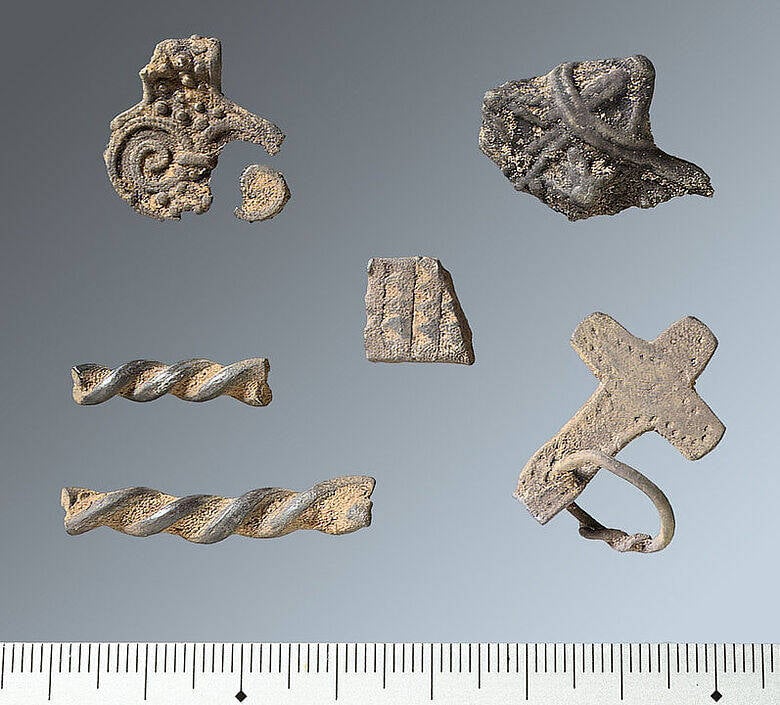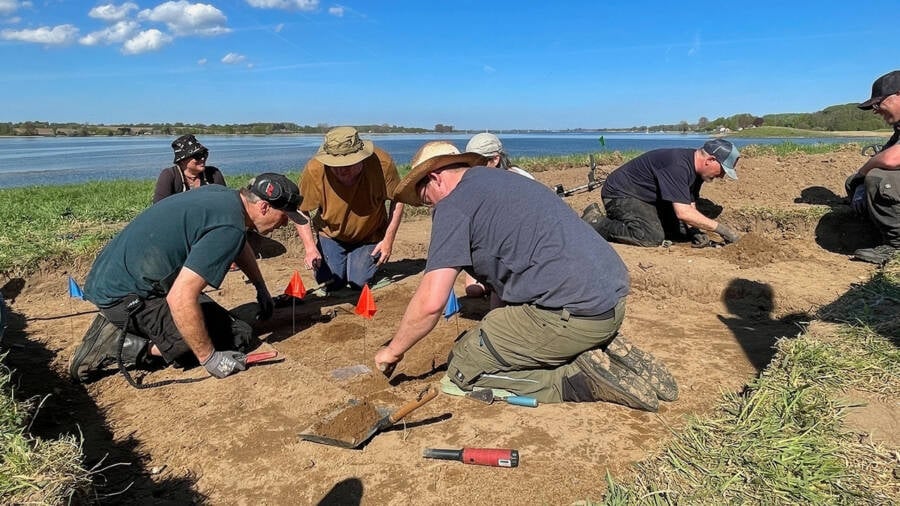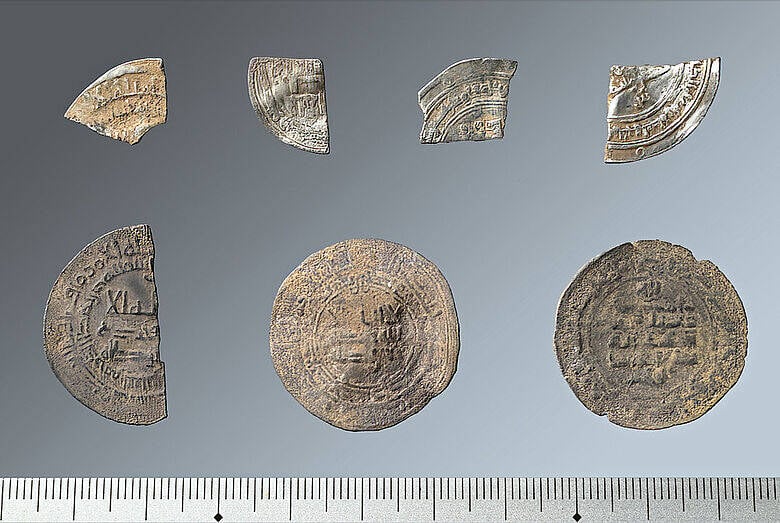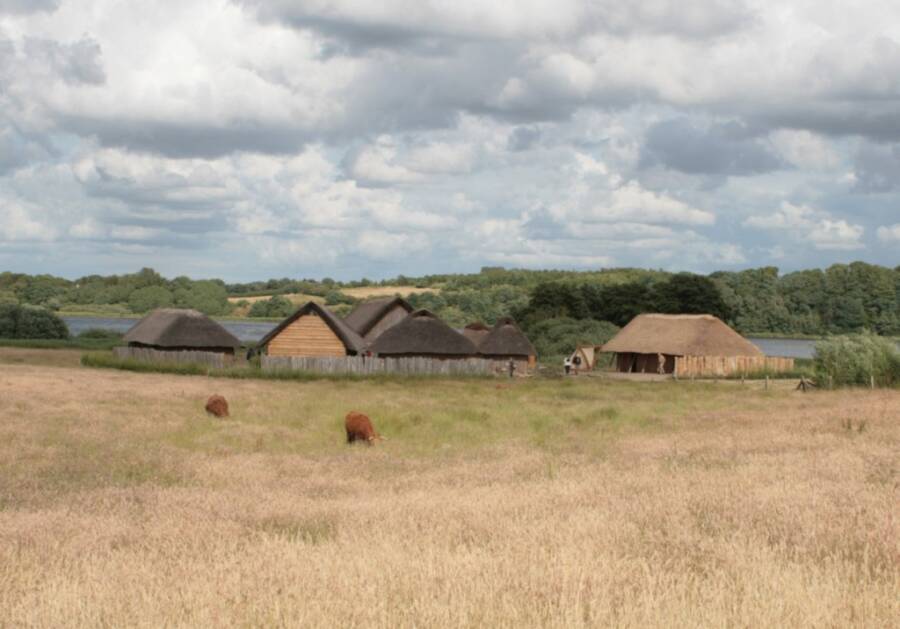The hoard dates back to the 10th century and includes one object that could be an early cross or an unfinished Thor's hammer.

Schleswig-Holstein State Archaeological OfficeSome of the treasures found in the Viking hoard in Germany.
Arjen Spießwinkel is no stranger to finding treasure. A member of a volunteer metal detector group in Schleswig-Holstein, Germany, Spießwinkel has found amazing historical objects before. Most recently, he stumbled upon a hoard of centuries-old Viking treasure near Germany’s Schlei River.
Seemingly buried in the 10th century, the hoard contains a number of fascinating objects, including coins, a whetstone, and a curious pendant that could be an early cross — or perhaps Thor’s hammer.
The Viking Hoard Near The Schlei River
According to Archaeologie Online, the Viking hoard was detected by Arjen Spießwinkel, a certified metal detectorist, along the banks of the Schlei River near Haithabu, Germany. Spießwinkel immediately notified the Schleswig-Holstein State Archaeological Office (ALSH), who came to examine the scene.

Schleswig-Holstein State Archaeological OfficeArchaeologists excavating the Viking hoard on the banks of the Schlei River.
The archaeologists found a wealth of treasure along the riverbank, including some 200 objects that date back to the 10th century. Experts suspect that they were buried at the river’s edge deliberately, either because someone wanted to hide them or because they were left as an offering.
“We are always happy when one of the [metal] detectorists calls us because he or she has discovered a hoard,” ALSH spokesperson Birte Anspach told All That’s Interesting. “Unfortunately, we can never find out exactly why the artifacts ended up in the ground. What motivated the owner to create a hiding place here? Was he on the run or did he have completely different motives for burying such valuable objects? We will probably never know.”
Most of the objects are made of silver and include hacksilver, fragments of Arab coins known as dirhams, pieces of ingots, and jewelry. Archaeologists also found a piece of ceramic and a whetstone, which could hint at the existence of a previously unknown 10th-century settlement.

Schleswig-Holstein State Archaeological OfficeArchaeologists found 200 objects during their excavation, including a number of coins.
One of the most intriguing finds in the hoard was a filigree cross pendant. The cross could be an early artifact from the Christianization of the region, though it’s also possible that the pendant is an unfinished Thor’s hammer, a sign that local people were still worshipping Norse gods.
“The eyelet for hanging it is located on the longer part of the ‘cross,’ so that the piece hangs upside down when worn,” Anspach said. “I can’t tell you that much about the cross-shaped pendant yet. But there are a few cross-shaped pendants that are actually worn on the head.”
The pendant might have been worn as protection. In Norse mythology, the god Thor used his hammer, Mjölnir, to protect Asgard, the home of the gods. A similar object was found in 2022 in Sweden.
Whether the pendant is a cross, a hammer, or something else entirely, it stands as an exciting reminder of the region’s long Viking history.
The Viking History Of Haithabu
Centuries ago, Haithabu was an important hub of Viking activity. According to the Haithabu Viking Museum, the town was likely first founded by Frisian merchants during the eighth century. Then, the Vikings moved in.
Advantageously placed alongside the Baltic Sea estuary, Haithabu became a key Viking trading hub between the ninth and 11th centuries. A crossroads for several important trade routes, Haithabu drew people from around the world, including Arab chronologer Ibrahim ibn Ahmed At-Tartûschi, who described Haithabu, one of the first large cities in northern Europe, as a “very large town at the outermost end of the ocean.”

Kai-Erik Ballak/Wikimedia CommonsReconstructed Viking houses near the Haithabu Viking Museum in Haithabu.
Christianity began to spread in Haithabu in the ninth century, when St. Ansgar — known as the “Apostle of the North” — traveled to the region. St. Ansgar sought to convert local populations in Northern Europe to Christianity, but it would take centuries for the religion to take root.
“[Christianization] began with St. Ansgar’s journeys to Haithabu and Birka in Sweden and the founding of churches there in the middle of the ninth century,” Anspach explained to All That’s Interesting. “However, it was not the case that Ansgar came — and suddenly everyone turned away from the old gods and followed the Christian faith. Christianisation was a long process that spanned several generations. One hundred years after Ansgar’s visit, most people in the area around Haithabu were still of pagan faith.”
Anspach continued: “Although there are individual finds with Christian symbols — for example in graves or among the settlement layers — the widespread adoption of Christianity did not take place until many decades later.”
As such, the discovery of the Viking-era objects on the banks of the Schlei River are part of a long and fascinating history. Not only do they hint at the presence of an unknown 10th-century settlement, but they include a pendant that may be an example of early Christianization.
After reading about the Viking hoard of 200 10th-century objects that was unearthed in Germany, discover the wild story of the Viking berserkers, the unstoppable warriors who fueled their bloodlust by ingesting hallucinogens. Or, go inside the surprising story of Viking helmets, which probably didn’t look much like how they’re portrayed in popular culture.





